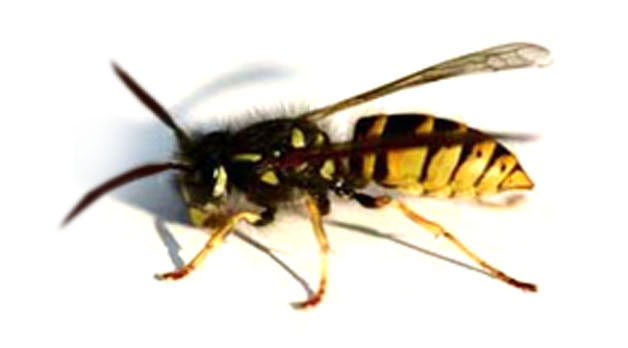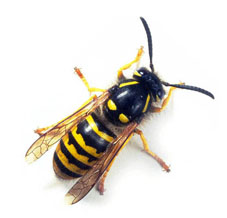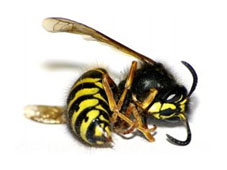Home
How much does the treatment cost?
How do I know if I have got a nest?
I appear to have wasps all over a bush
on a wall, is this a nest?
Will they come back next year?
Cant I just ‘block the hole’ or DIY
this problem?

How much does the treatment cost?
Properties in the Bradford area, Baildon, Shipley, Bingley,
Guiseley, Menston, Rawdon, Yeadon, £75
Roof nests where entry point
of insects is on the pitch of the roof higher than gutter/eaves £85
Other areas in West Yorkshire welcome, please contact
for an individual quote
Additional nests located on the same property and
treated at the same time just £15 in addition.
How do I know if I have got a nest?
A distinct pattern of wasp behaviour can be observed at
the entrance of a nest.
While the nest may not be visible, the insects will be
congregating at the entrance. This can
be a very small hole or crack. They will appear to be
coming and going on a "flight path".
Returning insects will often hover briefly near the
entrance then ‘disappear’ into the opening.
Wasps will leave the same area in a purposeful manner.
Places to look at if you suspect more wasps than usual
are bothering you in the
garden or appearing repeatedly in the same room of the
house.
• Around the gutter line and eaves outside or wasp activity in
the loft space.
• If you are finding insects in a bedroom or bathroom
in numbers, then stand back from the house
and look for the above described
congregating behaviour.
• Check each line of tiles further up the roof than the
gutter, or
where wood meets masonry such as window
ledges, facia boards and around Velux™
windows and lead flashings.
• Air bricks are frequently used as an exit for a nest situated in
the cavity wall and also vent openings.
• Check architectural features such as hollow roof
voids over porches, bay windows and wooden facia
cladding.
• Garden nests can be found in sheds, bird boxes, compost
heaps, hanging from bushes or trees or cracks
underneath steps.
Remember wasps do not hang around in groups unless they
are close to the area of their home.

I appear to have wasps all over a bush on a wall, is this a nest?
Not necessarily, again observe the pattern of behaviour.
Is each insect ‘hovering’ over the plant, appearing at
times to be dancing in its movements like a bee looking
for pollen or is it
‘zooming’ in from across the garden and after a brief touchdown,
disappearing behind the bush.
If the sun is out and literally dozens of insects are
appearing to hover it is probably just a local feeding ground not a nest
site.
Will they come back next year?
Each nest belongs to a single queen wasp and the whole
colony will eventually die out naturally as the cold weather draws in
towards the end of the year.
Prior to this, numerous new queen wasps will have been
nurtured within the nest, released into the community, mate and then
hibernate over the winter months.
The following spring, these individual queen wasps come
out of hibernation and start up the whole process again with their own
colony.
Treatment of the nest will wipe out that particular
colony, including all its potential queen wasps.
Old nests are not re-inhabited.
However if an active nest situated within the fabric of
the building is not correctly treated, then as the cold weather begins from
September onwards,
increasing problems start to occur. In an attempt to stay near warmth and
light, insects turn back on the property,
working their way into the rooms,
becoming trapped, crawling around half alive on the carpets and dropping
down in
increasing numbers onto window ledges.
Many people and their pets get stung at this time.
Cant I just ‘block the hole’ or DIY this problem?
The observable entrance to the wasps nest acts as the
‘front door’ through which the workers will service the nest.
Their behavior patterns will be similar to a scheduled
flight path and the wasps will have repeated a ‘follow my leader’
routine
for weeks if not months prior to discovering the wasps nest.
If this pattern is disturbed by blocking this entrance,
the colony will now attempt to create new exits from the building
and this
can lead to multiple routes being formed elsewhere.
Since successful treatment is often by treating and
shutting down the singular route being used it is easy to see how
blocking
can leave a lot of the insects escaping treatment.
A bit of a bee problem, Texas -
Youtube
tel: 01274 585479
mobile: 0797 189 2913
mail@thewaspman.co.uk

GDPR Privacy Policy
Personal data such as
name and contact details are obtained from clients to facilitate the provision
of our services and for accounting purposes. Information will not be shared with
any person or company not directly connected with the provision of our services
to our clients, or involved in our accounting processes. You can request a copy
of your personal data by telephone or e-mail. Please see our contact details.
Home



